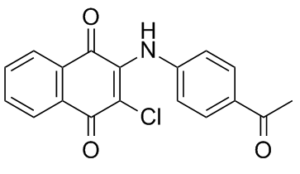This product is for research use only, not for human use. We do not sell to patients.

| Size | Price | Stock |
|---|---|---|
| 5mg | $60 | 3-6 Days |
| 25mg | $140 | 3-6 Days |
| 50mg | $200 | 3-6 Days |
| 100mg | $400 | 3-6 Days |
| 250mg | $750 | 3-6 Days |
| 500mg | $1100 | 3-6 Days |
| 1g | $1700 | 3-6 Days |
Cat #: V0088 CAS #: 130089-98-4 Purity ≥ 99%
Description: NQ301 is a synthetic 1,4-naphthoquinone derivative that acts as a selective CD45 inhibitor, displaying potent antithrombotic/antiplatelet activity. It exerts its antiplatelet activity by inhibiting collagen-challenged rabbit platelet aggregation with IC50 of 10 mg/mL.
Publications Citing InvivoChem Products
Product Promise

- Physicochemical and Storage Information
- Protocol
- Related Biological Data
- Stock Solution Preparation
- Quality Control Documentation
| Molecular Weight (MW) | 325.75 |
|---|---|
| Molecular Formula | C18H12ClNO3 |
| CAS No. | 130089-98-4 |
| Storage | -20℃ for 3 years in powder form |
| -80℃ for 2 years in solvent | |
| Solubility In Vitro | DMSO: ≥ 30 mg/mL |
| Water: N/A | |
| Ethanol: N/A | |
| SMILES Code | O=C1C(NC2=CC=C(C(C)=O)C=C2)=C(Cl)C(C3=C1C=CC=C3)=O |
| Synonyms | NQ-301, NQ 301, NQ301 |
| Protocol | In Vitro | In vitro activity: NQ301 significantly inhibited the collagen-, thrombin-, arachidonic acid-, thapsigargin- and calcium ionophore A23187-induced aggregation of washed human platelets with IC50 values of 13.0+/-0.1, 11.2+/-0.5, 21.0+/-0.9, 3.8+/-0.1 and 46.2+/-0.8 microM, respectively. NQ301 also significantly inhibited FITC-conjugated fibrinogen binding to human platelet surface GPIIb/IIIa complex, but failed to inhibit the fibrinogen binding to purified GPIIb/IIIa complex. These data demonstrate that NQ301 inhibits platelet aggregation by suppression of the intracellular pathway, rather than by direct inhibition of fibrinogen-GPIIb/IIIa complex binding. NQ301 significantly inhibited the increase of cytosolic Ca2+ concentration and ATP secretion, and also significantly increased platelet cAMP levels in the activated platelets. These results suggest that the antiplatelet activity of NQ301 may be mediated by inhibition of cytosolic Ca2+ mobilization, enhancement of cAMP production and inhibition of ATP secretion in activated platelets. Kinase Assay: NQ301 concentration-dependently inhibited washed rabbit platelet aggregation induced by collagen (10 microg/ml), arachidonic acid (100 microM) and U46619 (1 microM), a thromboxane A2 receptor agonist, with IC50 values of 0.60+/-0.02, 0.78+/-0.04 and 0.58+/-0.04 microM, respectively. NQ301 also produced a shift to the right of the concentration-effect curve of U46619, indicating a competitive type of antagonism on thromboxane A2/prostaglandin H2 receptor. NQ301 slightly inhibited collagen-induced arachidonic acid liberation. In addition, NQ301 potently suppressed thromboxane B2 formation by platelets that were exposed to arachidonic acid in a concentration-dependent manner, but had no effect on the production of prostaglandin D2, indicating an inhibitory effect on thromboxane A2 synthase. This was supported by thromboxane A2 synthase activity assay that NQ301 concentration-dependently inhibited thromboxane B2 formation converted from prostaglandin H2. Moreover, NQ301 concentration-dependently inhibited 12-hydroxy-5,8,10,14-eicosatetraenoic acid formation by platelets that were exposed to arachidonic acid. Taken together, these results suggest that NQ301 has a potential to inhibit thromboxane A2 synthase activity with thromboxane A2/prostaglandin H2 receptor blockade, and modulate arachidonic acid liberation as well as 12-hydroxy-5,8,10,14-eicosatetraenoic acid formation in platelets. This may also be a convincing mechanism for the antithrombotic action of NQ301. |
|---|
| Solvent volume to be added | Mass (the weight of a compound) | |||
|---|---|---|---|---|
| Mother liquor concentration | 1mg | 5mg | 10mg | 20mg |
| 1mM | 3.0698 mL | 15.3492 mL | 30.6984 mL | 61.3968 mL |
| 5mM | 0.6140 mL | 3.0698 mL | 6.1397 mL | 12.2794 mL |
| 10mM | 0.3070 mL | 1.5349 mL | 3.0698 mL | 6.1397 mL |
| 20mM | 0.1535 mL | 0.7675 mL | 1.5349 mL | 3.0698 mL |
This equation is commonly abbreviated as: C1 V1 = C2 V2
- (1) Please be sure that the solution is clear before the addition of next solvent. Dissolution methods like vortex, ultrasound or warming and heat may be used to aid dissolving.
- (2) Be sure to add the solvent(s) in order.




































